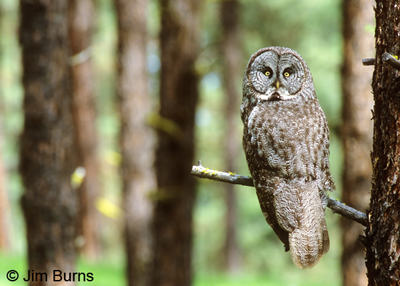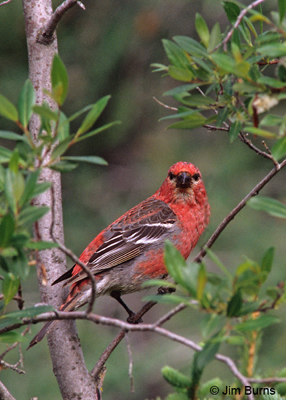
Undaunted, we decided to try again this year, our anticipation heightened by last year’s washout. You’ve probably heard the term “business birding,” which refers to packing your binoculars when you have to go out of town on work related trips, but is “vacation birding” a similar thing or just a redundancy? Don’t birders take their binoculars everywhere anyway?
I’ll let you decide after you read this prologue to our trip and the update which follows in the next column. Just to be clear, our priority for a Yellowstone vacation was to see and photograph its large mammals. Alright, I did make a list of five target birds, none of them Lifers, but all on the list because for one reason or another, mostly just bad timing or bad luck, I had not photographed them often or well. Or not at all! Every birder has at least one nemesis bird, right? Believe it or not, I have no photos of Ruffed Grouse.
Easily the most common species on my list and the most common member of its family, I have ten sight records for Ruffed Grouse over the years, two of them from Yellowstone itself. I’ve even taken two birding vacations (see how I juxtaposed those two words to acknowledge birding really was the priority on those trips) specifically for this species, all to no avail. Did I mention the term ‘nemesis bird’?
The Yellowstone sightings were over forty years ago hiking a trail known for bear activity, so bird photography was not top of mind at the time. That’s my best excuse, but we’ve seen Ruffed Grouse in six other states and two Canadian provinces since then, fleeting glimpses, or camera packed away, or wrong season to encounter families. Take your pick. As I made my list I rated my chances in two categories: sightings and photographs, 0>5, no chance to can’t miss. I gave the grouse a ‘5’ in the sighting category but, knowing my history with this bird, a ‘2’ for images.
The next most common bird on my Yellowstone list after Ruffed Grouse was Canada Jay, formerly known as Gray Jay and colloquially as the ‘camp robber.’ For both sightings and images, I gave this a ‘5’ because every time we’ve vacationed in the Rockies it’s found us before we even looked for it. I have over forty sightings of this species, one of them an entire family which flew off with my untended breakfast cereal bowl one year in Glacier National Park.
There are caveats, though. The species is in decline because of global warming. Not only has the Mountain Pine Beetle expanded its range in Lodgepole Pine forests, the stronghold of this jay, but warmer winters are causing spoilage of the cached food this early season nester depends on to raise its young. On our trip to Rocky Mountain National Park last September we were shocked that we saw many Clark’s Nutcrackers, but not a single Canada Jay. If they are/were so common on many of our travels, why do I have only a single photo of the species, that one of the southern race which lives in Arizona? Great question!
Next on my list is Golden Eagle, not really an uncommon bird, even here in Arizona, but all I have in my photo files are distant overhead shots, diagnostic to be sure, but nothing that excites me either artistically or from a natural history standpoint. I do have a head shot and a nice habitat shot . . . taken at the Phoenix Zoo! I’d love shots of this majestic raptor a lot closer, maybe with prey or a view of the dorsal wings.
We have seen this bird in Yellowstone on past trips, and of course its stronghold is the mountain west, so I’m hopeful and I’ll be alert to roadside raptors on the drive north to Wyoming. I put sighting possibility at ‘5,’ photo chances at ‘3,’ but I have not even seen a wild Golden Eagle for ten years since a memorable encounter in Arizona-
https://jimburnsphotos.com/pages/5-16-13.html
https://jimburnsphotos.com/pages/9-22-11.html
The two remaining target birds on my Yellowstone list surely fall into the realm of wishful thinking. Though we have actually seen the first of these in the park once, no birder would ever go there just to look for either Great Gray Owl or Pine Grosbeak though the habitat is good for both and they are seen periodically. We chanced upon the owl there forty years ago, not our Lifer, but only our second sighting at the time.
Since then we’ve only seen this forest wraith two additional times, once in Oregon where I captured wonderful images, but that was back in slide film days and there are only a few slides in my hanging files, no digital. Our chances for a sighting seemed slim, a ‘1,’ and for photos none, a ‘0.’
Slim and none would probably also apply to seeing a Pine Grosbeak on vacation birding in Yellowstone, but an actual birding vacation there might hold some promise. E-Bird research turned up five sightings for the park in 2022, though these might have been by local birders who knew the habitat well and birded there often. I gave Pine Grosbeak the same ratings as Great Gray, a ‘1’ and a ‘0.’
We have two handfuls of sightings for this beautiful finch, but I have only two photos. One of these, though, is a smashing image of a breeding male in a setting of northern Manitoba greenery. I even have three Arizona sightings of this extremely uncommon state breeder, but the last time I saw this species was in Alaska twenty years ago.
Whether it’s vacation birding or a birding vacation, every birder gets unexpectedly lucky on extended trips. Be sure to read my next column if you’re interested in how we did on our target list for this vacation birding, and which species was the most unexpected of the trip.